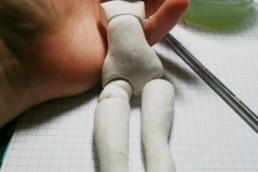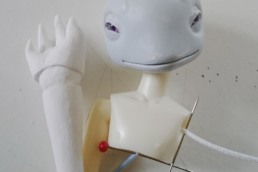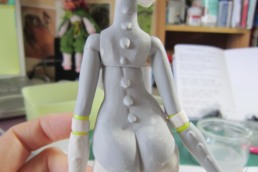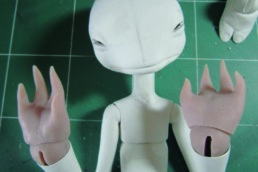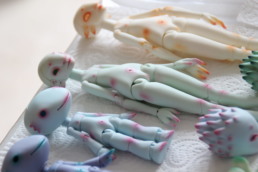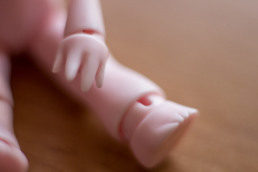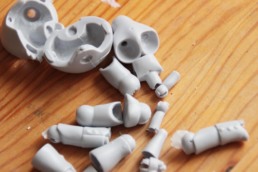Frequently Asked Questions
Here are the most asked questions.
If you can not find your answer despite everything, don’t hesitate to send me an email (mewiefish[at]gmail.com) or to use the contact form !
Creation
A BJD (Ball Jointed Doll) is an articulated resin doll. It is a doll intended for adults and collectors (it is not a toy for children). Most of the time it is made of resin, but it can also be made of porcelain or other materials (polymer clay etc.). It exists in lots of different forms: human (woman, man, child) or fantastic (centaurs, animals etc).
BJDs exist in several sizes which vary from less than 10 cm to more than 80 cm.
- Super Dollfie size (SD): About 60 cm, 1/3 scale .
- Mini Super Dollfie (MSD) size: About 42 cm, 1/4 scale.
- Yo Super Dollfie Size (YoSD): About 27 cm, 1/6 scale.
- Tiny: About 16 cm, 1/12 scale.
What makes the charm of BJD is that they are customizable at will: you can change the hair, the eyes, the clothes, the make-up or the appearance and sometimes the hands and feet. They are fully articulated, so you can handle them easily.
BJDs are a very rich artistic medium which allows numerous activities: sewing, make-up, drawing, photography, staging, knitting, decorating, painting, wigs / accessories making … They are often considered as piece of art and are frequently exposed in the window.
A very complete article to consult here for more info, or simply on wikipedia.
I am completely self-taught in terms of modeling and sculpture.
I like drawing from a very young age and I followed a 2-years training course in an art school, which allowed me to develop a certain graphic sense and to be able to transcribe on paper what I have in my head (nearly !). For BJDs, I spent a lot of time on internet to find tutorials, i observed a lot, i also trained and experimented a lot and i bought quality equipment to work in relatively good conditions (mask for dust / toxic fumes, dremel, scalpels, special clays etc). Having BJDs at home also made me better understand how they work knowing that all doll brands have their own ways of creating their dolls (and their posability/joints).
Of course I always continue to discover new things, to glean advice here and there, to train … there’s no secret: practice is the key, the more you practice, the more you progress!
I create all my models at home in my workshop.
I often start by drawing ideas on paper, then when the drawing is precise enough I move on to modeling. In general, I start with a full-size drawing of the front and profile, then I make a polystyrene frame which will be covered with Ladoll paste (sort of papier mache + air dry clay). I sculpt and model until I get the result that I like and then cut all the places where there will be joints (after having emptied the polystirene): this is the most technical and longest part because it is the one that requires the most adjustments for a good posability of the doll. Once the doll is complete, you have to sand each pieces very carefully, then pass them with spray paint to waterproof the surface (you need several layers of paint and fine sand between each layer of paint!).
Then the doll is ready to be molded with silicone and casted in resin. It is this part that I now entrust to my subcontractors.
All BJDs manufactured before 2016 were made entirely by me (molding, resin printing, sanding, assembly then customization if necessary).
Since the Radish guy (2016), I have used subcontractors in China and Korea for manufacturing: they take care of molding and resin casting. The work they offer is of very good quality. This working method allows me to offer lower prices than artist casting and saves me time for the creation part and the rest of my activity.
I currently no longer offer homemade casting for BJDs because I no longer wish to be in contact with certain toxic materials until I have a special place only dedicated to this activity. Sometimes I do it but for specific things and in small series (non-articulated creatures).
This is quite variable. For a unique creature, it can take a few hours or a few days, or even several weeks: between designing, modeling, painting, conditioning, for some the drying time, it can be long. It also depends on the size, the level of details you want, the finishing touches…
For a BJD, it takes more time, knowing that between a 15cm doll and a 60cm one, the time spent will not be the same either … For example, before being able to go to the molding, the Bactro model required work over a year. You have to design the model, make it, prime it and then sand it. If you want to do everything on yourself, you also have to make the molds, the resin casting, then all the pieces must be cleaned, sanded, drilled, assembled ; and if needed, you have to do a make up with several coats of varnish, let dry and then pack everything in a box (that was customized beforehand).
It really is a full time job that requires a total investment! Because in addition to the creation of a doll, as a freelance worker, you also have to take care of current orders, shipments, emails, promotion, social networks, administration etc …
For home resin casting and some creatures, i use some polyurethane resin mixed with UV resistant product and pigments.
For my prototypes and other creations, i use most of the time Ladoll air dry clay, magic sculpt/apoxie sculpt, prosculpt, wood glue, mastic or whatever do the trick ! 🙂
For make ups, i use acrylic paints (Liquitex, Pébéo), soft pastels (Rembrandt, Schmincke), watercolor pencils (Caran d’ache, Faber Castell), and air spray varnish (Citadel Purity Seal, Tamiya TS-80 flat). I’m curious to try one day varnish with my airbrush !
Achat
I only have 2 ways to sell my work :
- on internet (pre order, direct mail)
- on a booth during a doll show (for exemple the Ldoll festival in Lyon, a BJD dedicated festival)
So if you are interested in buying my work, please send me an email if the doll you want is available for sale, or during a pre order period (pre order periods are always signaled here or on the social medias).
It simply designates a pre-order (you pay in advance for a product that is not in stock at the moment ; as it exists for books / comics or others). This is the most common way to order in the BJD world because depending on the demand, you can’t have all the models in stock all the time.
This means placing an order for a doll and then waiting for it to be produced and shipped. Orders must be placed during a given period via an online form. (I usually leave between 2 to 3 weeks to order)
It is then possible to reserve your doll by completing an order form available during the pre-order time. You pay the amount of the doll in advance, in one or more installments, then as soon as the doll is available and fully paid, it is sent to you. (the production time is generally 3 to 4 months depending on the size of the doll and the schedule of the subcontractor).
I don’t offer a lot of pre-orders, so if you’re interested in a doll, it’s usually your only chance (in addition to the secondary market) to get it! Of course I sometimes offer releases of past dolls but it can take a year or two, or even more … and sometimes I no longer edit some of my dolls, so don’t miss the latest news !
That’s quite easy to find BJDs on internet:
- from artists or compagnies who have most of time their own online shop. That way, it avoids to people to buy a recast or bootleg doll (have a look at the next section about recast/bootleg dolls)
- from an officiel distributor
- from the second hand market
A few years ago, most of the shops and artists were in Asia (Japan, China and Korea), but now the offer has clearly grown and you can find BJDs everywhere (Europe, USA, Russia…). There is something for every taste !
Some exemples of artists shops or sites :
- Lillycat Cerisedolls
- Dust of Dolls
- Nympheas Dolls
- Irrealdolls
- Merry doll round
- Youpladolls
- La compagnie des radis
- Charles’ Creatures cabinet
- Depthdolls
- Fairyland
- Bimong
- Ipplehouse
- Doll Chateau
- Vita Magica
- Chimeradolls
- MarleneCloud dolls
- BlackCherry dolls
The list is not exhaustive because the number of companies/artists offering BJDs is very long !! Do not hesitate to make your own investigations to find the one that you like the most 🙂
Exemples of officials distributors:
- Octarine (europe)
- Jpopdolls (USA)
- Denver doll emporium (USA)
For the second hand market, the best is to go to the “sales” part of BJDs forums. The 2 most know places are:
- Matériel Céleste (french)
- Den of Angel (only english)
You will find also sales on Facebook groups like: BJD Sales Europe, Fairyland BJD Sales page, etc
Apart from the sales part, these forums are full of informations about many different subjects, I advise you to register if you want to know more about dolls!
I will not talk here about sites for clothes, accessories, eyes or wigs because there are too many of them! You will easily find lists on forums or blogs of collectors 🙂
Recast is the English term for the illegal reproduction of a doll, therefore counterfeiting. (“Re” = repetition, “cast”= resin casting).
Any unauthorized remolding of a doll from its original version and sold without the consent of the original company or artist is considered as a recast.
This is an issue that needs to be taken really seriously and is causing great harm to the doll community.
What the law says
Counterfeiting is defined as the reproduction, imitation or total or partial use of an intellectual property right without the authorization of its owner. It can be a trademark, a model, a patent, a copyright, a software, an integrated circuit or a plant variety.
More precisely, the INSEE defines the practice as “the reproduction, imitation or the total or partial use of a trademark, a design, a patent, a software or a right of author, without the authorization of its owner, by affirming or allowing to presume that the copy is authentic ”.
Thus, the counterfeiter will create confusion between the original product and the infringing product so that he seeks to appropriate the notoriety of another company or a brand and to benefit from the investments of the holder of the intellectual property right without his/her permission.
The intellectual property code defines it in Articles L. 335-2 and following as the reproduction, use, affixing or imitation of a mark; any copy, import or sale of a new invention; any total or partial reproduction of a design; any edition of writings, musical compositions, printed productions as well as any reproduction, representation or distribution of an intellectual work in violation of copyright, etc. Thus, there are several definitions of counterfeiting depending on the intellectual property right it infringes.
In any case, the role of intellectual property remains of prohibiting counterfeiting. This is the idea of intellectual property right protection of a monopoly: any act done outside that monopoly constitutes an infringement.
Criminal sanctions
- 3 years of imprisonment and a fine of 300,000 euros against natural persons, whether it is the counterfeiting of literary or artistic property (article L. 335-2 and s. CPI), drawings and models (article L. 521-2 and seq. CPI) or patent (article L. 615-14 and se. CPI), the penalties are identical. When the offense is committed by an organized gang, the penalties are increased to 5 years of imprisonment and a fine of 500,000 euros. In the event of a repeat offense, the penalties are doubled.
- Possessing a counterfeit object constitutes an act of concealment. Indeed, concealment is the fact of concealing, holding, transmitting, or acting as an intermediary in order to transmit something which we know comes from a crime or an offense (article 321-1 paragraph 1 of Penal Code). The offense also lies in benefiting, knowingly and by any means, from the proceeds of a crime or an offense (article 321-1 paragraph 2 of the Criminal Code). It is not enough for the person to invoke his ignorance of the origin of the thing for his good faith to be recognized.
- The concealer incurs the penalties of 5 years of imprisonment and a fine of 375,000 euros (article 321-1 of the Penal Code) but the penalties may be increased because of the concealment itself, in particular if it is customary, linked to facilities provided by the exercise of a professional activity or committed in an organized group as well as by reason of the original offense which can be punished more severely than simple concealment.
Counterfeiters exploit loopholes and administrative loopholes wherever they exist.
Counterfeiting distorts the game of fair competition and leads to heavy loss of incomes: for us who are self-employed, this can be dramatic because we can lose our jobs in the long run. The concern is also that the laws on counterfeiting are not the same everywhere in the world …
According to Interpol, “Counterfeiting is a full-fledged criminal activity that is not on the periphery of other criminal activities, but at the heart of them.”
In conclusion
Regarding dolls, the recast or counterfeit is well considered as outright theft of the creative work, the texts are quite clear and leave no room for debate. The recast cannot be justified by any reason.
Yes, a legit doll will always be more expensive than a recast doll, that’s normal: when you buy a doll from an artist, you don’t just pay for the object itself, you pay through this the time spent creating the doll (we are not paid when we create), expertise and experience, professional service, after-sales service if necessary; you allow a self-employed person to pay for care or to take a little vacation (self-employed people like me do not have paid vacations, that’s one of the aberrations of our status), to pay themselves food, shelter and clothes, to be able to afford the means to continue to create. Most people who work full time creating dolls have precarious statuses, so buying recast dolls will only increase the precariousness of our professions and in the long run reduce the supply of interesting things on the market, even no longer have any novelties at all. Recasters do not take the risk of this unpaid time: they only recover the work already done to reproduce it at low cost. What a rich and noble life project! … That’s a pitiful attitude in my opinion.
Of course it can happen to buy a counterfeit doll out of ignorance, this is not uncommon when you have just discovered BJDs and are not too familiar with the environment. There are a lot of sites that offer dolls at very low prices, on ebay, etsy or others, so beware if you see a doll at 45 € for example … Often the price is a discouraging factor for a first purchase (I know very well, I’ve been there!), but there are models that are quite affordable while remaining in a respectful approach to the creator. If it’s too high, just be more patient to save money enough to buy the doll later 🙂 And keep in mind that BJDs remains a luxury hobby for most people…
I refer you to the Instagram page of BJDawareness (in English only) which dealt with subjects such as where to get a doll for less than 100 € while remaining legit.
I would also like to point out that many companies and artists currently offer installment payments to make their creations accessible to as many people as possible. I offer layaway options for my creations because I know it’s a budget and as a collector I appreciate having easy payment options.
Warning: there are unfortunately pro recast groups as well as communities claiming to buy and promote recasts. Obviously I advise you to stay as far away as possible from this nauseating community which has no respect and no consideration for the artistic process in general. These are the people who are slowly killing this hobby by allowing and supporting thieves to live on the activities of others …
For my part, being recasted means having to stop my activity in the more or less long term …
Don’t hesitate to ask other anti-recast people in the community to refer you if you are in doubt about a purchase! 🙂


 FR
FR